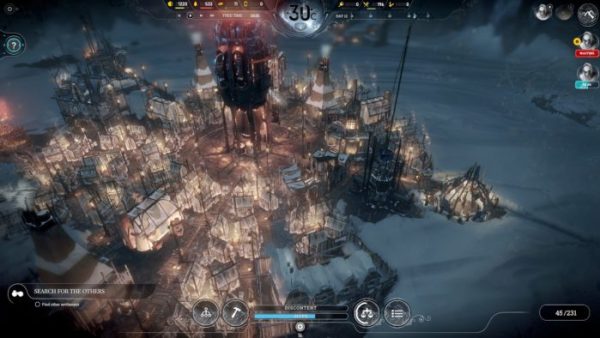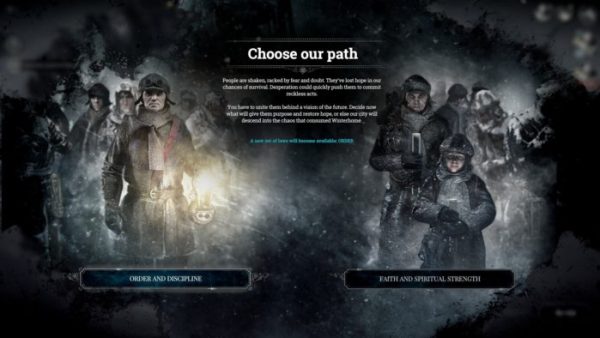Frostpunk on PC
City-builder games have a funny way of capturing a player’s attention. The core gameplay loop is simple yet effective: provide housing for your people, give them jobs, keep them happy, expand your borders, and then reap the rewards. It’s a blueprint that has remained largely unchanged since the inception of the genre, and you won’t find many contemporary city-builders that stray too far from its mold. Yet, every now and then, we get a gem that takes that same formula and adds to it in unique and innovative ways to produce a game with a distinct sense of style and character. Enter Frostpunk.
Developed by 11 Bit Studios, Frostpunk is a shockingly bleak game. This shouldn’t come as much of a surprise when you take a look back at This War of Mine, the studio’s 2014 hit survival game that was inspired by the civilian side of the Bosnian War. Instead of focusing on a select few characters, however, Frostpunk zooms out to expand the scale a little, crafting a narrative around a civilization and its development. In the world of Frostpunk, nature has frozen over, and the main scenario (titled A New Home) sees you lead a group of survivors from London as you build a new city from scratch. At the center of your radial city is a generator to keep your people warm. This is the lifeblood of your city. If the generator fails, you die.
This premise suits the city-builder genre remarkably well. As the leader of this new city, it’s your job to keep your civilians happy while also making sure you’re collecting enough resources to sustain life in a frozen wasteland. At first glance, the mechanics seem overwhelming. Coal, wood, and steel serve as the primary resources you’ll need to harvest to keep things going, and you’ll also have to assign enough workers to each job to make sure you’re operating as efficiently as possible. Once you’ve got the basics, you can start building tents for housing, as well as other buildings to start generating food rations. Then there are work shifts to keep track of; your civilians will only work 10 hours a day at the start of the game, and you’ll need to learn the difference between workers and engineers to assign them to appropriate jobs. Then there are laws that you can pass every 18 hours, along with a technology tree you can look into in order to improve your facilities. At the same time, there’s also a Hope and Discontent meter that indicates how well your people are doing.
Frostpunk introduces a lot of important mechanics right out of the gate, and while the tutorials themselves are clear enough most of the time, it’s still a lot to take in when you’re just getting started in a game with brutal conditions and factors to take note of. If you’re not already a seasoned city-builder player, I highly recommend starting the game on a lower difficulty to get a hang of the mechanics before playing on normal difficulty. Once you familiarize yourself with the ins and outs of Frostpunk, the game becomes a lot more enjoyable on its default setting.

As mentioned before, the generator is the heart of your new city. Much of the gameplay loop revolves around you trying to harvest as much coal as possible to keep it running. At the start, it’s enough to simply send out workers to dig up coal piles. But when those dry up, you’ll have to figure out new ways to keep the coal flowing, whether it’s through building coal thumpers or mines as a renewable source. The generator itself keeps the city warm, but Frostpunk consistently adds to the challenge by dipping the temperature every now and then. As you progress through the main scenario, the temperature will get lower, forcing you to upgrade your generator’s heat power and range. And as you upgrade the generator to make it even more powerful, you’ll need more coal to keep it running, which means you need to dedicate more manpower to building coal thumpers and harvesting them.
If your generator runs out of coal, it’s game over. Thankfully, the game does offer you a few ways to recover from costly mistakes. Early on in the game, I’d made the mistake of getting too complacent with my coal supply and found myself in a situation where I only had enough to keep the generator running for a few more hours. In cases like these, Frostpunk gives you a way out. You can sign a law that allows you to implement 24-hour emergency shifts, where you can force your workers to work around the clock to shovel more coal for you. Or, if you don’t have enough manpower to do the shoveling, you can pass a law for child labor instead, which is exactly what I did in my moment of desperation.
Of course, everything you do in the game has consequences. The child labor law only allows you to put children to work at safe jobs. Shoveling coal and working in a cook house are considered safe enough, but passing this law just leads you down a slippery slope where you’ll eventually unlock the option to put children in more dangerous jobs like mining factories where they could get seriously hurt. On the other hand, if you managed to refrain from going down the child labor route, you could build child shelters, helping to increase the city’s Hope meter, and potentially educate them to become medical or engineering apprentices for the future.
Things get pretty serious later on when you gain access to a new book of laws in an effort to give the people hope. You have the option of instilling order in the city and to rule with a firm hand (that definitely has the potential to become an authoritarian iron fist), or to preach faith and hope that your people can find strength from within. It’s a great risk-reward balance that forces you to think of both the short- and long-term consequences.
No matter what you do, Frostpunk always asks the same question: how far are you willing to go to ensure the city’s survival?
The law system itself is interesting, as there are often two options you can choose from for each situation. For instance, you can choose to build a cemetery for your dead civilians, or go for a more surgical corpse disposal method. You could opt for radical treatment for frostbite, or leave your sick in care houses where you can spend more resources to sustain them until you find a better way to treat them. The game allows you to pass a new law after every 18 in-game hours, and these are vital to managing your people’s Hope and Discontent.

The Hope and Discontent meters are pretty self-explanatory. While they’re not exactly inversely proportionate, they play a large role in determining how your city functions. High Discontent increases the chances of troublemakers popping up in your city, and you might have to deal with them in lethal ways, which could cause your Hope meter to fall. If you keep your Hope up, however, your civilians may be less inclined to skip out on their work shifts during a cold snap. Managing the two meters is important for keeping your city running; losing control of either meter could very easily spell trouble for you.
Outside of that, Frostpunk also does a good job of throwing curve balls at the player and making sure that you’re never too comfortable. The main scenario provides you with a few objectives and tasks to complete within a time period, and there’s always some sort of conflict to resolve, whether it’s dealing with a new influx of survivors or trying to quell your people from rioting against you. And when the game decides to up the stakes, it really ups the stakes. When the temperature drops drastically, the music gets even more intense as the violins cry, and you’re forced to dig deep to rally your people to make sure you have enough food and resources to stay alive. You could install heaters in workplaces to keep your workers warm, as long as you have enough coal to keep all that fire burning. People are more prone to falling ill when it’s cold, and if you don’t have the necessary medical facilities to treat them properly, they’ll die.
Before long, you’ll start seeing your people as nothing more than tools to help keep your generator running and the city ticking. And yet, Frostpunk constantly reminds you that your people have feelings, too. What’s most impressive is the effort the game puts into making you feel like the civilians are actual people looking to you for guidance. Clicking on an NPC’s body gives you all their basic information: their family members, their biggest worries, their living conditions. Every now and again, you’re forced to make hard decisions regarding a civilian’s health and efficiency output. It’s a pretty morally demanding game, and at the end of it all, you’re left with a bleak sense of introspection as you wonder if Frostpunk is actually a critique on the cold-heartedness of governing bodies and human nature. It hits hard like that.
After you’ve survived the main scenario, Frostpunk also offers a couple other scenarios for you to try. One involves you protecting seedlings from the elements and managing the city with automated machines, while the other sees you protecting a group of poor London refugees from the cold and the wealthy who seek to oppress them. Yeah. The scenarios are all equally bleak. There’s enough content here to keep you invested for tens of hours, and the game is great at providing new challenges for you to wrap your head around. Even the main scenario provides some replay value in terms of the major law categories you can choose during its turning point.
Frostpunk is an extremely polished city-builder game that builds upon the genre’s core mechanics with meaningful innovations. Despite the steep learning curve at the start, it manages to be captivating every step of the way while never forgoing that rush of adrenaline you get when the game strips away your power and complacency with yet another ethically conflicting challenge.
Score: 4.5/5 – Great
Pros
| Cons
|
For more information on how we review games, check out Twinfinite’s review policy here.

